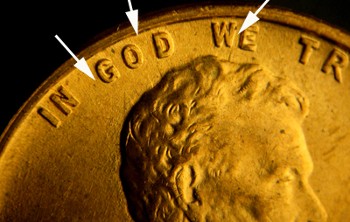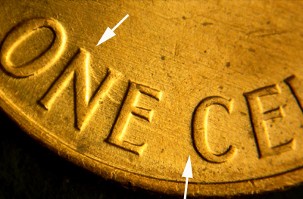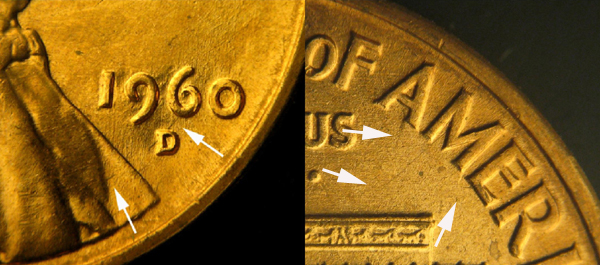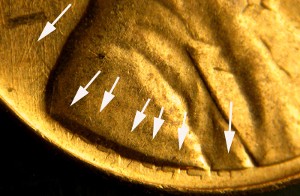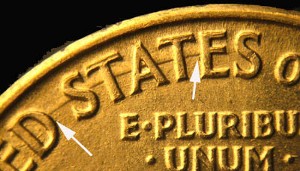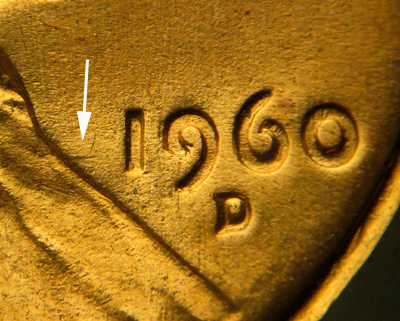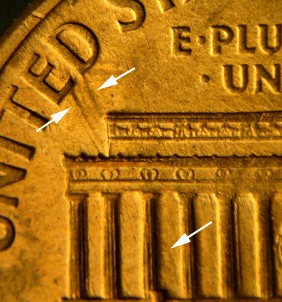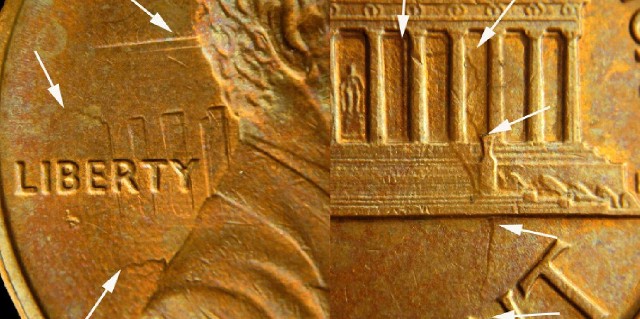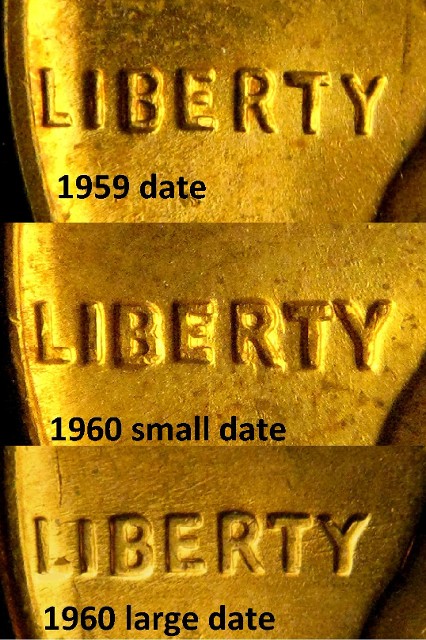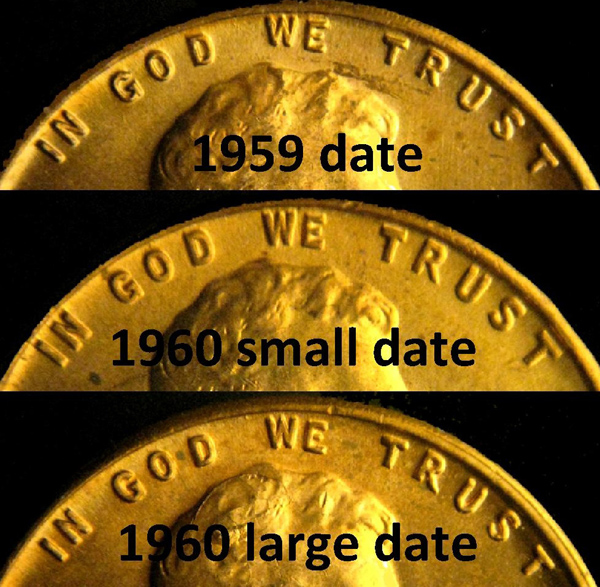SPECIAL: Follow-up to Article Published in Coin World
The Mysterious 1960 Small Date Lincoln Cent
By BJ Neff, NLG
It was a pleasant surprise to have read the 20 November, 2006 edition of Coin World and found that Eric von Klinger had written in his “Collectors’ Clearinghouse” column about my earlier work concerning the 1960 small date Lincoln cents. Even at that time, I had felt that there was something that was a bit mysterious about the less than one year change to the obverse die and the reasoning why the 1960 small date of the Lincoln cent was discontinued.
In the year 2006, I had established that the 1960 small date Lincoln cent master die was the first to be made, strengthening LIBERTY and IN GOD WE TRUST from what was found on the 1959 Lincoln cent obverse master die. The discontinuation of the small date, according to the U.S. Mint, was a problem that arose with the working dies chipping out in the smaller 0 digit of the date. To correct this problem, the 0 digit was enlarged along with the 6 and 9 digits for balance in the larger date 1960 cent. On the surface, this did sound like a plausible explanation.
We now move forward to the year 2010 and the conception of MADdieclashes.com. This site, which deals with the odd and unusual die clashes, was Mike Diamond’s brain child but was built with equal contributions from Jason Cuvelier, Bob Piazza, and myself. This is where the second part of the story concerning the 1960 small date Lincoln cent began.
One of the rarer types of die clash is the tilted die clash (vertically misaligned die clash). This is where one or both dies are tilted relative to the horizontal plane so that when the dies do meet, only peripheral design elements are clashed into the other die’s field near the rim. We must remember that the working dies are convex shaped, so an appreciable tilt must be present to produce such a die clash. Imagine the action of the hammer die hitting a planchet with a full transfer of its design onto that planchet. Then imagine that same die tilted to such a degree that, in the absence of a planchet, it transfers only a small amount of its design into a small area. With this mental picture, it’s easy to understand why the tilted die clash is very rare.
Vertical Misaligned Die Clash (Conventional Type) is the definition we use on MADdieclashes.com to define a tilted die clash. If you look at the entries for this particular die clash type, you will find that there are 37 assorted clashes under this heading (with more on the way) (The entries can be found under “atypical die clashes” for the Lincoln Memorial cent). That doesn’t sound so rare, does it? However, if they are all found on just one denomination for just one year, that does make it a bit more interesting. Now add the fact that, to date, all tilted die clashes have been found on the 1960 and 1960D small date Lincoln cents. It would seem that, the 1960 small date Lincoln cent does indeed have an untold story.
We should first look into the unusual tilted die clashes found on the small date 1960 Lincoln cents. The first set of clash marks (obverse and reverse) consists of the partial letters of ONE CENT found protruding from Lincoln’s head. Specifically, these clash marks consist of the NE of ONE and the C of CENT. On the reverse die, a line from the top of Lincoln’s profile passes through the word ONE and the C of CENT.
Working clockwise, the second set of clash marks can be seen around the date and the mint mark in this 1960-D cent (Picture #2). On the obverse face, a clash line from the bottom of the letters in AMERICA can be seen from the bottom of the 6, extending through the mint mark, and finally on to the lower portion of Lincoln’s bust. On the reverse face, the mint mark can be clearly seen clashed into the bottom of the ME of AMERICA. The jacket clash line as well as the jacket fold can be seen cutting across the bottoms of the letters AM of AMERICA.
The third set of clash marks are the result of STATES being clashed into the area below the bottom of Lincoln’s bust (Picture #3). On the obverse face, a partial D from UNITED, plus partial letters from the word STATES can be seen clashed into the area below Lincoln’s bust. The reverse face shows the lower line of Lincoln’s bust clashed through the word STATES and into the D of UNITED. In other specimens with a similar clash, the lower back of Lincoln can be seen clashed into the D of UNITED and into the roof / cornice of the Memorial building.
There are two other die clashes that should be mentioned as well. The first is caused by the roof of the Memorial building being clashed onto the obverse die in the area of the date. It is seen as a rather short bar protruding from the front of Lincoln’s jacket and at times it does extend into the first digit of the date.
The other die clash pattern is created by the lower back of Lincoln’s bust as it passes through either the D or E of UNITED. There are just a few of these dies that show the partial letter D on the obverse die and only one instance where the jacket line can be seen in bay 3 of the Memorial building.
It is peculiar that, having examined over 5000 small date 1960 Lincoln cents from both mints, not one had the usual die clash seen on Lincoln cents. All the die clashes are located well away from the center of both dies. For those of you, who are not familiar with the common Lincoln cent die clash, please refer to the picture below.
Now that we have a concept of what is occurring with the die clashes, let us take a look at a few more odd facts. Pick up any small date 1960 Lincoln cent, and the one feature that will be noticeable is the abundant die scratches, especially in the areas where the clash marks can be frequently found. Presently, we have listed 35 separate dies on MADdieclashes.com that have had clash events, some having evidence of more than one clash event affecting that single die. I have approximately 15 more dies to be added to the site on my desk, and I am still searching rolls of 1960 small dates. If we look at the Memorial Lincoln cent series, beginning with its start in the year 1959 and during any of the next ten years, we will not find a single year with that many different die clashes. Even in the early 1980’s, with the large amount of die clashes found during that period that amount pales in comparison to what was found on the 1960 small date
Another odd fact is that you can find coins struck with conflicting dies. A conflicting die is one that will show clash marks from the opposing die, while the opposing die is free of them. For example, a coin will have the partial letters of STATES clashed under Lincoln’s bust on the obverse die but does not show the corresponding clash mark of the lower bust line through the word STATES. This can be explained by the removal of one or both dies after a clash event, subsequent abrasion to remove the clash marks and then a failure to put both back into service as a mated pair.
The current practice of the U. S. Mint seems to involve replacing the obverse die after anything more than minor clash, while abrading the reverse die. But there is no period of time where both the obverse and reverse dies were heavily abraded and kept in service.
The next step is to go back and revisit the stories from the U. S. Mint concerning the small date 1960 Lincoln cents. When the small date was first noticed by coin collectors, the mint director, W. H. Brett, denied that any changes had taken place. It was later that the Mint corrected that statement and admitted that both a small date and large date 1960 Lincoln cent were in circulation. As I had mentioned in the beginning of this article, the Mint stated that the change was necessary to correct a problem with the small 0 in the date chipping out. The 0 in the date was made larger, along with the 6 and 9 digit to balance the proportions of all the digits. In his 2006 column, Eric von Klinger had mentioned that I believed that the 9 digit was actually an inverted 6 digit which was punched into the master die. Since that time we have found that the digits in the date were actually engraved into the master die and not applied through a punch.
After looking at the 5000+ small date cents from the year 1960, I found none with a chipped out 0 digit — the supposed problem that ceased its production! Yes, there were a few dies with chipped out 6 digits and more dies with chipping in the R of LIBERTY. However, that is not the area that the Mint had stated was the problem. So, exactly what was the malfunction with the 1960 small date Lincoln cent?
While we will never know exactly what did happen at the U. S. Mint to make it abandon the use of the small date on the 1960 Lincoln cent, but let us look at what we do know. The 1960 small date cent master die was made sometime in 1959, from which was then made the various working hubs and working dies. After the working dies were completed, the Denver mint mark was applied to the allotted amount for service to that mint. The production began in the beginning of the year with the Denver mint making the first of that year’s Lincoln cent a coin press. There are two obvious facts that the small date Lincoln cent was odd; first, the location of the die clash marks seen where they had never been seen before and the frequency of the die clashes that did occur on the small date cents.
Let’s examine the first fact. With the majority of the die clash events being the tilted die clash variety (the reason I say majority is that I am sure one or two will be found with a die clash marks found in the center of the die), the hammer die may have had a different mounting system in the coin press than seen in previous years. This tilting of the hammer die could have been a designed feature to lessen the impact of the dies when they did clash, which in turn would reduce the number of the obverse dies discarded after a clash. Alternatively, it may have been just an unusual effect of the way the hammer die was mounted in the coin press.
The second fact points to a problem in the planchet delivery system. With the extremely large number of clash die events occurring with the small date Lincoln cent, it did indicate there was a problem. With each clash event, the coin press would have to be stopped, the dies examined for damage and then either replaced or abraded to remove the clash marks. Exactly why this problem did occur cannot be pinpointed. However, this problem may have doomed the small date Lincoln cent. But why make another complete set of new working dies from scratch?
We know that the large date and small date working hubs for 1960 were the same physical shape. This is evident in the four working dies (3 proof dies and one Denver mint die) that were hubbed with both a small and large working hubs (Class III doubled dies). After the master die had completed the working hubs and the working hubs the working dies of the small date 1960 Lincoln cent, it may have been deemed that the master die and working hubs were too worn to produce working dies. This would necessitate the making of a new master die, working hubs and working dies. But why switch to the large date version of the Lincoln cent in that same year, which duplicated the work that had previously been accomplished on the small date Lincoln cent? Was there some other factor that made the small date Lincoln cent uniquely different that the previously manufactured working dies for that version of the Lincoln cent were unusable? Again, we can only guess what that difference may have been, but surely it was not because the digits in the date were chipping out as the mint stated.
Another odd phenomenon has been observed in connection with both versions of the 1960 Lincoln cent. In the making of the master die for the year, the previous year’s master hub (or a preceding year’s master hub) was employed to make that new master die by abrading the last two digits (in some cases the last three digits) of the date from that master hub. The new master die was made and the last two digits were engraved into the newly formed die.
However, it appears that the small date 1960 master die was made from a previous year’s master hub that had all design elements removed except for Lincoln’s bust. This is also true for the large date 1960 Lincoln cent as well. If we compare the word LIBERTY in a 1959 cent to the same word in both the 1960 small date and large date cent, we can see obvious differences in the lettering. Look at the picture to the right and while the word LIBERTY does appear to be the same in all three examples, closer scrutiny reveals a difference in just about all the letters.
We can also see similar differences in the motto IN GOD WE TRUST pictured below from the two dates and the large and small date 1960 cent.
Again, we must ask, why did the mint go to the trouble of making a new master die without LIBERTY and IN GOD WE TRUST only to have those two design elements engraved into that new master die? We can see that the motto had not yet migrated to the edge of the die for the positioning of LIBERTY and IN GOD WE TRUST appear the same for 1959, 1960 small date and 1960 large date. It has been noted by both James Wiles and me that the 1960 large date master hub was used without change up until the year of change in 1969. In 1968, the master hub from its continuous use to make master dies had spread Lincoln’s bust outward to a point that the motto had merged with the rim. But that does not explain the mint’s actions in 1960 and still leaves us wanting a better understanding of just what went on at the mint in that year. Could this have been a situation similar to what the mint experienced with the web note [1]?
We now have a somewhat clearer picture of what may have happened in 1960 to the Lincoln cent. Of course this information is all based on conjecture. Would the Mint tell the real story? I am not too sure that they would, since they did not readily admit to the small date / large date change at the time, and then they provided some misinformation concerning the reason for that change.
So, the next time that you are searching those small date Lincoln cent rolls from the Denver mint looking for RPM’s, also look for those unique die clashes. You may be presently surprised at what you can find.
[1] The web note was printed on a high speed printing press that did not live up to the expectations of the Mint. The one dollar bill was the only limited note printed on this press type.
